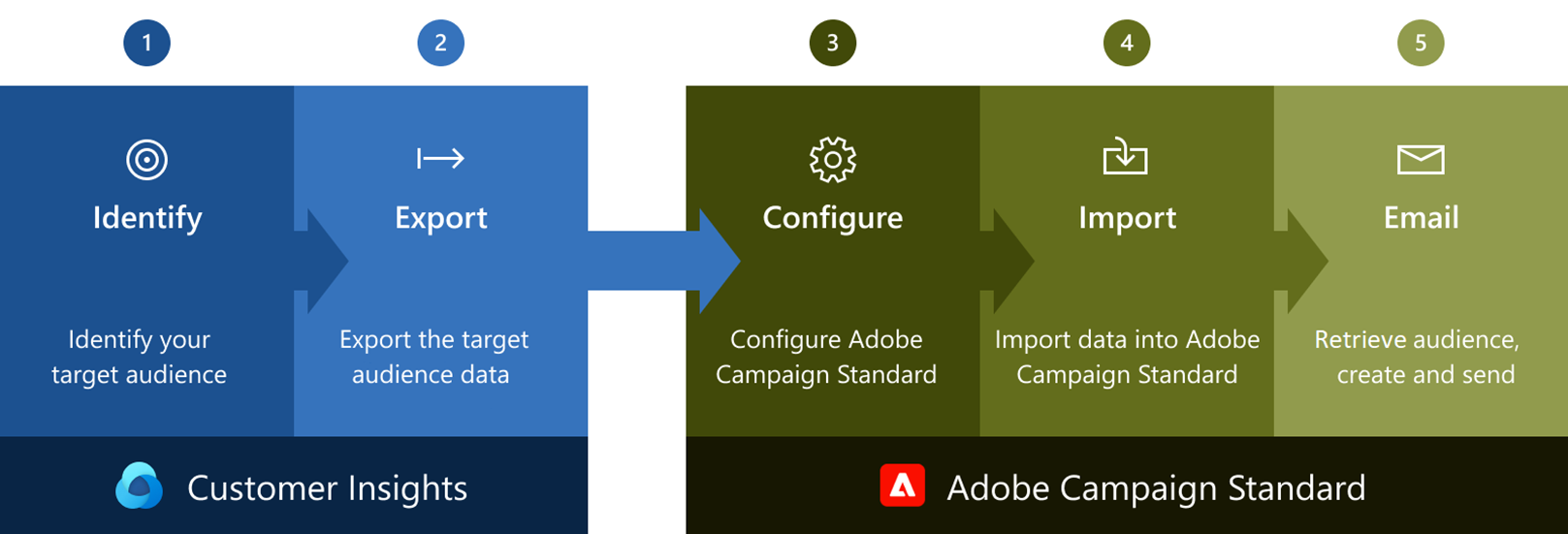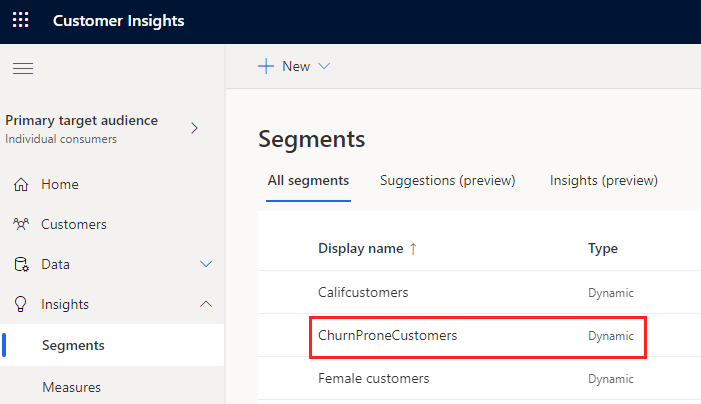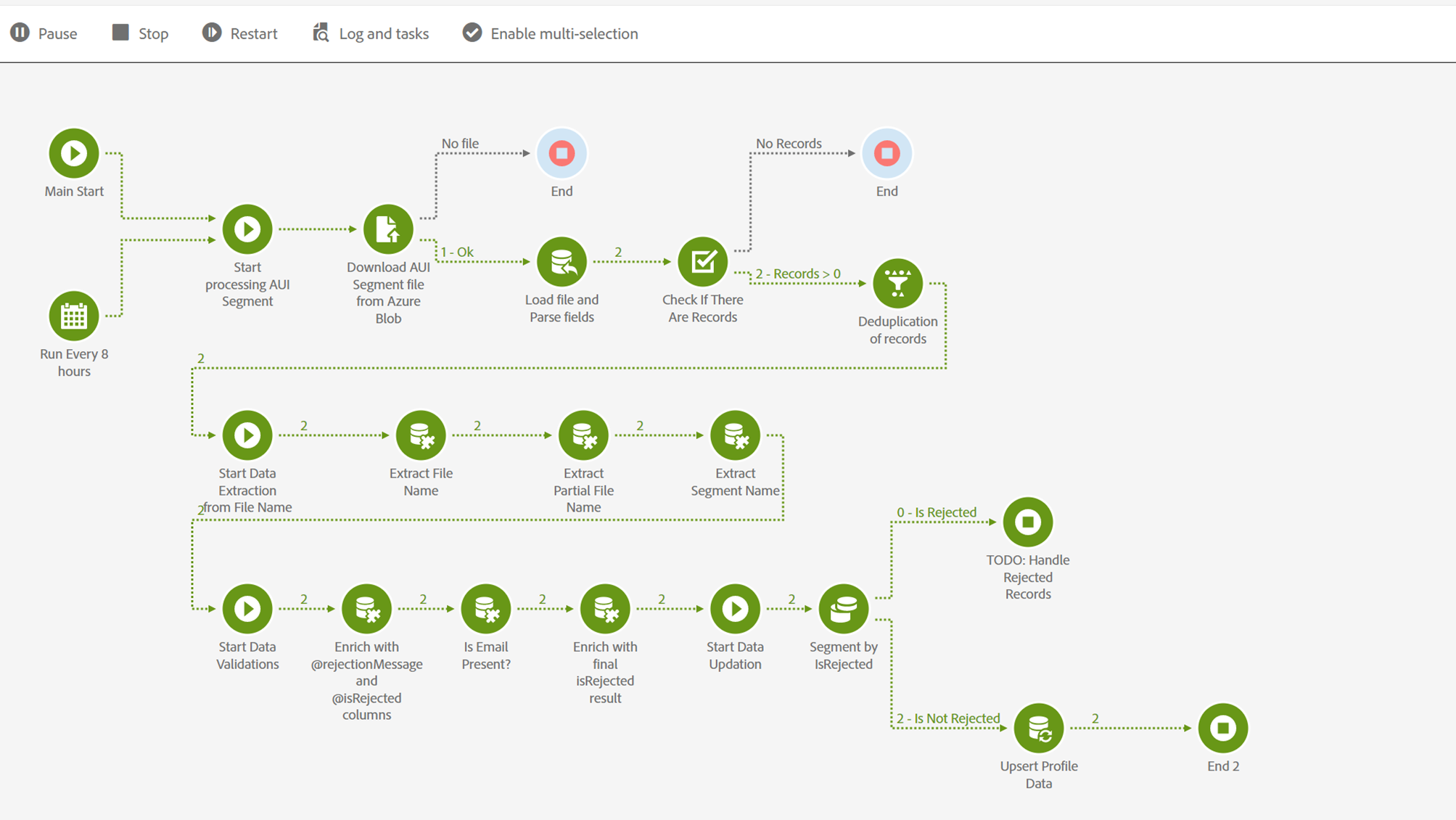Export segments to Adobe Campaign Standard (preview)
[This article is prerelease documentation and is subject to change.]
Export segments that target relevant audiences to Adobe Campaign Standard.

Prerequisites
- An Adobe Campaign Standard license to use Adobe Campaign.
- To setup the export in Customer insights the same prerequisites as for Export to Azure Blob storage apply:
- An Azure Blob Storage account with a container.
- User who sets up the connection must have the permission to access the content of the container. For example, a Blob Storage Contributor role.
- The Customer Insights Service Principal has write permissions on the container. For example, a Blob Storage Contributor role.
Campaign overview
To better understand how you can use segments from Dynamics 365 Customer Insights - Data in Adobe Experience Platform, let’s look at a fictitious sample campaign.
Let’s assume that your company offers a monthly, subscription-based service to your customers in the United States. You want to identify customers whose subscriptions are due for renewal in the next eight days but haven't yet renewed their subscription. To keep these customers, you want to send them a promotional offer via email, using Adobe Campaign Standard.
In this example, we want to run the promotional email campaign once. This article doesn’t cover the use-case of running the campaign more than once. However, Customer Insights - Data and Adobe Campaign Standard can be configured to work for a recurring campaign scenario too.
Identify your target audience
In our scenario, we assume that the email addresses of the customers are available in Customer Insights - Data and their promotional preferences were analyzed to identify members of the segment.
The segment you defined in Customer Insights - Data is called ChurnProneCustomers and you plan to send these customers the email promotion.

The offer email that you want to send out will contain the first name, last name, and the subscription end date of the customer. It informs the customers about the discount they’ll get if they renew their subscription before it ends.
Export your target audience
Set up connection to Adobe Campaign
You must be an administrator in Customer Insights - Data to add a connection.
Go to Settings > Connections.
Select Add connection and choose Adobe Campaign.
Give your connection a recognizable name in the Display name field. The name and the type of the connection describe this connection. We recommend choosing a name that explains the purpose and target of the connection.
Choose who can use this connection. By default, it's only administrators. For more information, see Allow contributors to use a connection for exports.
Enter Subscription, Resource group, Storage account, and Container for your Blob Storage account.
Optionally, if your storage account is behind a firewall, select Enable Private Link. For more information, go to Private Links.
Review the data privacy and compliance and select I agree.
Select Save to complete the connection.
Configure an export
To configure this export, you must have permission for this connection type.
Go to Data > Exports.
Select Add export.
In the Connection for export field, choose a connection from the Adobe Campaign section. Contact an administrator if no connection is available.
Enter a name for the export.
Choose the segment that you want to export. In this example, it's ChurnProneCustomers.

Select Next.
Map the Source fields from the segment to the Target field names in the Adobe Campaign Standard profile schema.

If you want to add more attributes, select Add attribute. The target name can be different from the source field name so you can still map segment output from Customer Insights - Data to Adobe Campaign Standard if the fields don’t have the same name in the two systems.
Note
Email address is used as an identity field but you can use any other identifier from the customer profile to map data to Adobe Campaign Standard.
Select Save.
Saving an export doesn't run the export immediately. The export runs with every scheduled refresh. You can also export data on demand.
Note
Ensure that the number of records in the exported segment are within the allowed limit of your Adobe Campaign Standard license.
Exported data is stored in the Azure Blob Storage container you configured above. The following folder path is automatically created in your container: %ContainerName%/CustomerInsights_%instanceID%/% exportdestination-name%%segmentname%%timestamp%.csv
Example: Dynamics365CustomerInsights/CustomerInsights_abcd1234-4312-11f4-93dc-24f72f43e7d5/ChurnSegmentDemo_ChurnProneCustomers_1613059542.csv
Configure Adobe Campaign Standard
Exported segments contain the columns you selected while configuring the export. This data can be used to create profiles in Adobe Campaign Standard.
To use the segment in Adobe Campaign Standard, extend the profile schema in Adobe Campaign Standard to include two additional fields.
In our example, these fields are Segment Name and Segment Date. We will use these fields to identify the profiles in Adobe Campaign Standard we want to target for this campaign.
If there are no other records in Adobe Campaign Standard, other than what you are going to import, skip this step.
Import data into Adobe Campaign Standard
Import the prepared audience data from Customer Insights into Adobe Campaign Standard to create profiles using a workflow.
The import workflow in the image below has been configured to run every eight hours and look for exported segments (.csv file in Azure Blob Storage). The workflow extracts the .csv file content in a specified column order. This workflow has been built to perform basic error handling and ensure that each record has an email address before hydrating the data in Adobe Campaign Standard. The workflow also extracts the segment name from the filename before upserting into Adobe Campaign Standard profile data.

Retrieve the audience in Adobe Campaign Standard
Once the data is imported into Adobe Campaign Standard, create a workflow and query the customers based on the Segment Name and Segment Date to select profiles that were identified for our sample campaign.
Create and send the email using Adobe Campaign Standard
Create the email content and then test and send your email.
